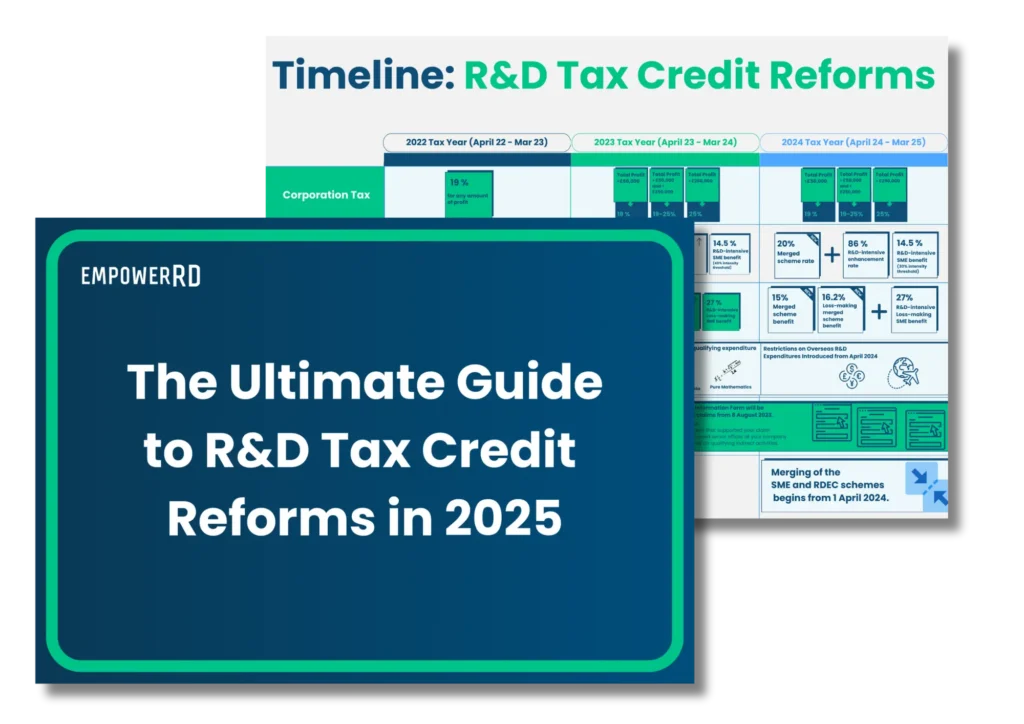On September 29 HMRC released the latest official R&D tax credit statistics 2022. They confirm that innovation continues to be key to the success of UK businesses – even during the most testing time of the pandemic.
At EmpowerRD, the updated statistics are used by our clients to benchmark their claims through our platform’s benchmarking tool, helping them to see how their claims compare to their peers’.
The new stats released include finalised figures for the 2018-2019 and 2019-2020 tax years, as well as projected numbers for 2020-2021. Final data for the latter period will be released next year.
Benchmark your claim against the latest statistics
Our R&D tax claim benchmarking tool has been updated to include HMRC’s latest available data. In just 2 steps, you’ll quickly see how your claim compares to other companies, both in the same scheme, as well as industry.
You’ll also get helpful tips on what your claim size might suggest to HMRC. For example, if it’s likely to have been under increased scrutiny as a result of being in the top percentile of claims, we recommend what you should do for your next claim to reduce risk. See how your company’s R&D tax claim stacks up.
EmpowerRD’s key takeaways
For the first time since 2000, the value of R&D tax credit claims drop
For the first time ever, the projected total value of R&D tax credit support claimed has decreased by 4% from the previous year to £6.6 billion. This corresponds to £38.1 billion of R&D expenditure, which is 11% lower than the previous year.
Interestingly, the decrease in expenditure from the previous year is largely driven by a decrease in expenditure from companies claiming through the RDEC scheme. Meanwhile, SME scheme expenditure remained roughly the same.
Total support claimed R&D tax credits by scheme, 2014-15 to 2020-21 (£million)
While the expenditure on R&D may have dropped, the number of businesses claiming did not: the number of businesses claiming increased by 7%, from 85,900 in 2019-20 to 89,300 in 2020-21. Of the 89,300:
- 78,825 claimed via the SME scheme
- 10,475 claimed via the RDEC scheme
Number of claims for R&D tax credits by scheme, 2014-15 to 2020-21
Has COVID had an effect on the numbers?
This accounting period (20-21) covers the early chapter of COVID-19, so it’s not surprising to see a drop in the value of claims. Lots of businesses endured lockdowns and economic pressures that may have prevented them from carrying out R&D at normal levels.
It’s possible that qualifying R&D expenditure could decrease in the next few years due to COVID and other economic conditions, such as the war in Ukraine. However, it’s important to remember that the HMRC is adding new qualifying costs, like data and cloud computing bills, in April 2023. This means businesses will be able to claim a larger deduction for expenses.
Usual sectors dominate
The Information and Communication, Manufacturing and Professional, Scientific and Technical sectors make up 62% of the total volume claims, and 70% of the total amount claimed for the tax year 2020 to 2021. This is not surprising, these are the most R&D-intensive sectors and have always been the top sectors when it comes to the scheme.
Alignment between ONS and HMRC stats
The Office for National Statistics (ONS) publishes several additional National Statistics on R&D in the UK, including the Business Expenditure on Research and Development (BERD) survey. It has been previously mentioned that there are discrepancies between HMRC and ONS estimates of R&D expenditure, which has made it hard to compare the two.
This year, HMRC mentioned in their published stats that they and ONS have collaborated to compare the estimates, publishing a joint ONS-HMRC article describing how to interpret both sources.
We welcome this coordinated approach, as it helps HMRC to make more informed policy decisions.
Have any further questions about the scheme? We’re here to help – please get in touch.













